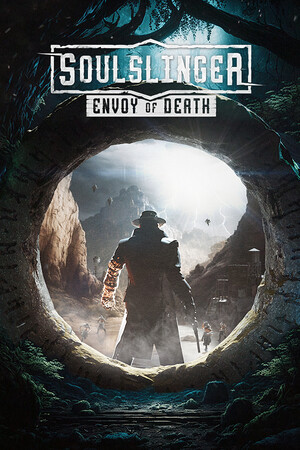Soulslinger: Envoy of Death Free Download Direct Steam-Cracked
Character Customization: Defining the Envoy
In Soulslinger: Envoy of Death, character customization forms the very core of your journey through Limbo. As the Envoy, you are not a mere spectator but the architect of your own power and fate. The game offers an intricate character progression system that allows you to define your playstyle with precision and depth.
The customization begins with Traits and Attributes. Players can allocate points into core stats such as Strength, Agility, and Spirit. Strength enhances physical damage and health, Agility increases speed and critical hit chances, while Spirit governs your supernatural powers and energy regeneration. This triad forms the backbone of combat style, allowing for diverse builds like the tanky brawler, swift gunslinger, or ethereal spellcaster.
Beyond raw stats, the Skill Trees are where true customization shines. The game features three major skill trees:
-
Gunslinger Path focuses on precision, quickdraw abilities, and rapid-fire skills. Upgrades here include enhanced reload speed, bullet ricochet, and critical shot bonuses.
-
Spectral Arts delve into the Envoy’s supernatural side, unlocking powers like soul siphoning, phantom shields, and spectral teleportation. These abilities are resource-intensive but game-changing in tough battles.
-
Forge Mastery improves weapon crafting and modifications, allowing players to create unique hybrid guns and imbue them with elemental effects such as fire, ice, or shadow.
Each skill tree is designed to complement the others, encouraging players to mix and match according to their preferences. For example, combining Gunslinger speed with Spectral teleportation creates a hit-and-run master, while a heavy Forge Mastery build can turn the Envoy into a walking arsenal.
Class Archetypes exist as presets or guidelines for new players, with archetypes like The Reaper, The Duelist, and The Wraith providing balanced builds that can later be customized further. Players who enjoy experimentation can abandon these presets and invest points freely, tailoring abilities for niche strategies.
Cosmetic Customization is another layer of personalization. Although Soulslinger’s grim setting focuses on function over flair, the game offers unlockable skins, weapon designs, and emblems that reflect your journey and achievements. Players can choose from ghostly motifs, battered armor sets, or even visual effects for their supernatural powers.
A significant feature is the Soul Bind System, which ties certain upgrades and weapon stats directly to the Envoy’s current soul essence. This essence fluctuates based on your actions—helping NPCs, defeating bosses, or completing challenges can enhance your soul power, unlocking temporary buffs or permanent unlocks.
Furthermore, Permadeath and Legacy Mode impact character progression deeply. While death in standard mode means restarting, Legacy Mode lets you carry forward a fragment of your Envoy’s essence, preserving some skills and items but resetting others, forcing players to continually adapt.
All these layers of customization ensure that each run feels fresh and rewarding. Players are encouraged to experiment, forge new identities, and find their personal definition of what it means to be the Envoy of Death.
Weapon Crafting: Forging Death Itself
Weapon crafting in Soulslinger is not just about creating tools of destruction—it’s a ritual of empowerment and transformation. Every bullet fired, every slash made by the Envoy’s crafted weapons carries a piece of your essence, making crafting one of the deepest and most strategic elements of the game.
At the heart of the system is the Forge, located in Haven. Here, players collect resources—called Soul Shards, Scrap Metal, and Arcane Residue—from defeated enemies and exploration. These materials are the currency of creation, allowing you to build, upgrade, and modify a diverse arsenal.
Base Weapon Types include revolvers, shotguns, rifles, and experimental arcane firearms. Each has distinct characteristics:
-
Revolvers offer high precision and critical hits but lower magazine capacity.
-
Shotguns excel at close-range crowd control with wide spread damage.
-
Rifles provide long-range lethality with balanced fire rates.
-
Arcane firearms blend gunpowder and magic, unleashing elemental projectiles and effects.
Players can modify base weapons using the Forge’s upgrade system. Attachments range from extended barrels that increase range, enchanted grips boosting reload speed, to soul cores that add elemental damage like fire, frost, or void energy.
Synergy builds are key to mastering weapon crafting. Certain upgrades unlock combo bonuses when paired. For instance, a fire elemental barrel combined with an explosive grip causes incendiary area damage on kills, setting the battlefield ablaze. Similarly, combining frost effects with shotgun spread creates freezing shockwaves that slow multiple enemies.
The crafting process also involves weapon crafting trees, which detail progressive upgrades requiring increasingly rare materials. At higher tiers, players can craft legendary weapons with unique traits—such as self-replenishing ammo, homing bullets, or shadow clones that mimic your attacks.
Beyond raw power, players can customize weapon aesthetics—from glowing runes etched into barrels to ghostly auras that shimmer with soul energy. These visual upgrades have no direct gameplay impact but serve as status symbols within the game community.
A particularly innovative aspect is the Weapon Soul Fusion mechanic. This allows players to merge two weapons temporarily, combining their stats and abilities for a limited duration during a run. This fusion demands strategic timing and synergy knowledge, as the effects are amplified but can also cause instability—leading to unexpected side effects like misfires or recoil spikes.
Weapon durability adds another layer of depth. Continuous use without maintenance will degrade performance, requiring players to decide whether to repair at the cost of resources or risk breakdowns mid-combat.
In addition to crafting, weapon experimentation is encouraged. Secret recipes can be discovered by piecing together clues from NPCs, environmental hints, or unlocking hidden quests. These secret builds often involve rare components and provide powerful, sometimes game-changing effects.
Ultimately, weapon crafting in Soulslinger is about personalization and adaptation. Each weapon is a reflection of the Envoy’s soul—shaped by the player’s choices and battle scars, turning guns into extensions of their will to survive and dominate Limbo’s chaotic battlefields.
NPC Factions: Allies, Betrayals, and Politics of the Dead
Limbo, the twilight realm of Soulslinger, is as much a political battleground as it is a deadly war zone. NPC factions each represent different ideologies, power struggles, and shades of morality, providing a dynamic backdrop that influences both gameplay and story.
The primary factions include:
-
The Revenants
Ghostly warriors who have sworn to uphold a strict code of honor. They are bound to protect the sanctity of Limbo’s natural order. Revenants value discipline and order, often providing the player with combat support and exclusive gear if alliances are forged. However, their rigid hierarchy can lead to conflict, especially when the Envoy’s methods disrupt the status quo. -
The Hollow Syndicate
A ruthless cartel controlling smuggling and black-market souls. The Syndicate thrives on corruption and exploitation, using intimidation and sabotage to maintain dominance. Aligning with them opens access to powerful but morally questionable weapon upgrades and black ops missions. Betrayal is commonplace here, and trust is a rare commodity. -
The Echoes
Mysterious spectral entities focused on uncovering the forgotten history of Limbo. They deal in secrets and knowledge, offering quests that unravel deeper lore and unlock hidden abilities. Echoes favor cunning and intellect over brute force, rewarding players who engage with puzzles, exploration, and diplomacy. -
The Forsaken
Outcasts and rebels, often former Envoys who failed their missions. They operate on the fringes of Limbo, engaging in guerrilla warfare against dominant powers. Forsaken allies provide unique tech-based weapons and unpredictable combat styles, but their distrust of outsiders makes cooperation difficult.
Interactions with these factions are not merely transactional. Dialogue trees and choice-based quests shape your relationships, determining which faction benefits you most. Choosing to help one faction often puts you at odds with another, creating branching narrative paths and different endings.
NPCs within each faction have distinct personalities and motivations. For example, Captain Mara of the Revenants is a stoic warrior torn between loyalty and personal doubt, while Sly Ruckus, a Syndicate informant, oscillates between helpfulness and deceit depending on your reputation.
Some NPCs can be recruited as allies or companions, offering unique combat perks or passive bonuses. These companions also have side quests revealing their tragic backstories, enriching the worldbuilding and emotional impact.
The political landscape is further complicated by betrayals and shifting alliances. Players may be forced to choose between saving a faction leader or seizing power for themselves, with each decision rippling through the game’s ecosystem.
Finally, faction reputation influences the shops and resources available to players. Higher standing grants access to rare items, crafting materials, or shortcuts in missions, while poor relations close off opportunities or spawn ambushes.
In essence, NPC factions in Soulslinger add depth, tension, and replayability, making every run through Limbo a unique political and emotional journey.
Artistic Design & Music: A Haunting Symphony
Soulslinger: Envoy of Death captivates not only through gameplay but also through its masterful artistic design and evocative music—both essential in immersing players in the eerie, melancholic atmosphere of Limbo.
The art direction blends western motifs with fantastical, spectral elements. The environment design uses muted color palettes dominated by grays, blues, and sepia tones—emulating dust-covered ghost towns and twilight deserts. This restrained use of color accentuates the occasional vibrant bursts from soul energy or weapon effects, drawing attention and creating dramatic contrast.
Level design favors verticality and layered architecture, with crumbling buildings, winding alleys, and vast barren landscapes filled with subtle environmental storytelling. Rusted signage, faded graffiti, and scattered relics hint at past lives and forgotten histories, encouraging exploration.
Character models combine realism with ghostly distortion. The Envoy’s spectral form flickers with energy, weapons glow faintly with soul power, and enemies range from tormented revenants to shadowy beasts born of regret and rage. Visual effects—such as particle-based soul wisps, dynamic lighting, and weather effects like dust storms—heighten tension and immersion.
The user interface (UI) is minimalist yet functional, designed to keep players focused on action while providing quick access to vital information. Fonts and HUD elements carry a weathered, vintage style that complements the world’s aesthetic.
Sound design is equally sophisticated. Ambient sounds such as wind whistling through abandoned streets, distant howls, and faint whispers create an unsettling backdrop. Enemy movements and weapon fire are finely tuned for impact and clarity.
Music is a key emotional driver, composed of layered orchestral and electronic elements. The score dynamically adapts to gameplay, with quiet, haunting melodies during exploration swelling into intense, rhythmic pulses in combat. These adaptive music layers respond to player health, enemy proximity, and story beats, heightening immersion and emotional resonance.
The combined effect of artistic design and music is a haunting symphony—a sensory experience that evokes loneliness, danger, and the faint glimmer of hope amidst the darkness.
Endgame Content: Mastery of Limbo
The journey in Soulslinger does not end with defeating the final boss. Instead, the game opens into a rich endgame ecosystem designed to test mastery, creativity, and endurance.
Late-game dungeons push players into procedurally generated labyrinths with escalating difficulty, environmental hazards, and puzzle elements. These dungeons reward exploration with rare crafting materials, unique weapons, and powerful skill unlocks.
Legacy Mode, a permadeath loop variant, encourages repeated runs with progressively harsher conditions. Each cycle resets most progression but grants legacy points that unlock permanent global bonuses, new character skins, and alternate skill trees, encouraging players to experiment with fresh builds.
Leaderboard systems track player performance in challenge runs—speed clears, high score challenges, and special modes like “No Death” or “Soulless Runs.” These leaderboards foster competitive spirit and community engagement.
The game also features seasonal updates introducing limited-time events, new weapons, faction storylines, and cosmetic rewards. Seasonal leaderboards reset to keep the competition fresh and to provide ongoing reasons to return.
Challenge runs provide unique modifiers such as “One Bullet Only,” “No Healing,” or “Reverse Controls,” forcing players to rethink tactics and sharpen skills.
Endgame content also expands narrative threads, revealing deeper secrets about Limbo, the Envoy’s origins, and the true nature of death itself. Players uncover lore-rich storylines through hidden areas, secret NPC dialogues, and encrypted journals.
Ultimately, endgame in Soulslinger is about mastery—refining your Envoy, pushing your build to its limits, and exploring every corner of a world that continuously evolves and challenges.
Developer Commentary: Behind the Veil
Behind Soulslinger’s grim facades and gunfire lies a passionate team committed to redefining rogue-lite storytelling and gameplay. In interviews, lead designer Maya Calderon explains the narrative philosophy: “We wanted death to feel meaningful—not just a restart, but a story chapter. The Envoy’s journey is a cycle of hope and despair, growth and loss.”
The team focused heavily on rogue-lite mechanics that reward player choice and adaptation. Procedural generation was balanced with handcrafted elements to maintain both unpredictability and narrative coherence.
AI design was a significant challenge. Enemy behaviors needed to be varied and reactive, forcing players to learn and strategize, yet remain fair. The AI system uses layered state machines combined with procedural tactics that evolve with player skill.
Community feedback shaped many systems. Early testers requested deeper weapon crafting and faction consequences, leading to the complex forge and political systems seen today.
Live service roadmaps promise seasonal content, quality of life improvements, and expanded narrative arcs. The developers emphasize listening to the player base, with plans to introduce community-driven events and mod support.
In essence, Soulslinger is a living project—an evolving symphony of death and rebirth, shaped by both its creators and its players.
SYSTEM REQUIREMENTS
- OS: Windows 10 64-bit
- Processor: Intel I5 4690 / AMD FX 8350
- Memory: 16 GB RAM
- Graphics: Nvidia GTX 1060 / AMD Radeon RX 580
- DirectX: Version 12
- Storage: 30 GB available space
Game Insights
- Genre: Action, Adventure, Indie
- Developer: Elder Games
- Platform: PC
- Game Size: 31.9 GB
- Released By: RUNE emu
- Version: v1.0 | Full Version
- Full PC Games


